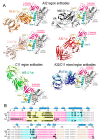Structural Basis for Epitopes in the gp120 Cluster A Region that Invokes Potent Effector Cell Activity
- PMID: 30654465
- PMCID: PMC6357199
- DOI: 10.3390/v11010069
Structural Basis for Epitopes in the gp120 Cluster A Region that Invokes Potent Effector Cell Activity
Abstract
While a number of therapeutic options to control the progression of human immunodeficiency virus (HIV-1) now exist, a broadly effective preventive vaccine is still not available. Through detailed structural analysis of antibodies able to induce potent effector cell activity, a number of Env epitopes have been identified which have the potential to be considered vaccine candidates. These antibodies mainly target the gp120 Cluster A region which is only exposed upon viral binding to the target cell with epitopes becoming available for antibody binding during viral entry and fusion and, therefore, after the effective window for neutralizing antibody activity. This review will discuss recent advances in the structural characterization of these important targets with a special focus on epitopes that are involved in Fc-mediated effector function without direct viral neutralizing activities.
Keywords: A32; ADCC; C11; HIV; structure; vaccine.
Conflict of interest statement
The authors declare no conflict of interest.
Figures


Similar articles
-
Structural definition of an antibody-dependent cellular cytotoxicity response implicated in reduced risk for HIV-1 infection.J Virol. 2014 Nov;88(21):12895-906. doi: 10.1128/JVI.02194-14. Epub 2014 Aug 27. J Virol. 2014. PMID: 25165110 Free PMC article.
-
Cocrystal Structures of Antibody N60-i3 and Antibody JR4 in Complex with gp120 Define More Cluster A Epitopes Involved in Effective Antibody-Dependent Effector Function against HIV-1.J Virol. 2015 Sep;89(17):8840-54. doi: 10.1128/JVI.01232-15. Epub 2015 Jun 17. J Virol. 2015. PMID: 26085162 Free PMC article.
-
Targeting the Late Stage of HIV-1 Entry for Antibody-Dependent Cellular Cytotoxicity: Structural Basis for Env Epitopes in the C11 Region.Structure. 2017 Nov 7;25(11):1719-1731.e4. doi: 10.1016/j.str.2017.09.009. Epub 2017 Oct 19. Structure. 2017. PMID: 29056481 Free PMC article.
-
Structural Features of Broadly Neutralizing Antibodies and Rational Design of Vaccine.Adv Exp Med Biol. 2018;1075:73-95. doi: 10.1007/978-981-13-0484-2_4. Adv Exp Med Biol. 2018. PMID: 30030790 Review.
-
Conformation-Dependent Interactions Between HIV-1 Envelope Glycoproteins and Broadly Neutralizing Antibodies.AIDS Res Hum Retroviruses. 2018 Sep;34(9):794-803. doi: 10.1089/AID.2018.0102. Epub 2018 Jul 17. AIDS Res Hum Retroviruses. 2018. PMID: 29905080 Review.
Cited by
-
Antibody-dependent cellular cytotoxicity targeting CD4-inducible epitopes predicts mortality in HIV-infected infants.EBioMedicine. 2019 Sep;47:257-268. doi: 10.1016/j.ebiom.2019.08.072. EBioMedicine. 2019. PMID: 31501077 Free PMC article.
-
Across Functional Boundaries: Making Nonneutralizing Antibodies To Neutralize HIV-1 and Mediate Fc-Mediated Effector Killing of Infected Cells.mBio. 2021 Oct 26;12(5):e0140521. doi: 10.1128/mBio.01405-21. Epub 2021 Sep 28. mBio. 2021. PMID: 34579568 Free PMC article.
-
Three families of CD4-induced antibodies are associated with the capacity of plasma from people living with HIV to mediate ADCC in presence of CD4-mimetics.medRxiv [Preprint]. 2024 Jun 4:2024.06.02.24308281. doi: 10.1101/2024.06.02.24308281. medRxiv. 2024. Update in: J Virol. 2024 Oct 22;98(10):e0096024. doi: 10.1128/jvi.00960-24. PMID: 38883797 Free PMC article. Updated. Preprint.
-
Modulating HIV-1 envelope glycoprotein conformation to decrease the HIV-1 reservoir.Cell Host Microbe. 2021 Jun 9;29(6):904-916.e6. doi: 10.1016/j.chom.2021.04.014. Epub 2021 May 20. Cell Host Microbe. 2021. PMID: 34019804 Free PMC article.
-
Immunotherapy with Cell-Based Biological Drugs to Cure HIV-1 Infection.Cells. 2021 Dec 28;11(1):77. doi: 10.3390/cells11010077. Cells. 2021. PMID: 35011639 Free PMC article. Review.
References
-
- WHO Data and Statistics. [(accessed on 3 January 2019)]; Available online: http://www.who.int/hiv/data/en/
-
- Richard J., Pacheco B., Gohain N., Veillette M., Ding S., Alsahafi N., Tolbert W.D., Prévost J., Chapleau J.-P., Coutu M., et al. Co-receptor Binding Site Antibodies Enable CD4-Mimetics to Expose Conserved Anti-cluster A ADCC Epitopes on HIV-1 Envelope Glycoproteins. EBioMedicine. 2016;12:208–218. doi: 10.1016/j.ebiom.2016.09.004. - DOI - PMC - PubMed
Publication types
MeSH terms
Substances
Grants and funding
- AI129769/National Institute of Allergy and Infectious Diseases/International
- AI116274/National Institute of Allergy and Infectious Diseases/International
- R01 AI129769/AI/NIAID NIH HHS/United States
- AI120756/National Institute of Allergy and Infectious Diseases/International
- P01 AI120756/AI/NIAID NIH HHS/United States
LinkOut - more resources
Full Text Sources
Other Literature Sources

